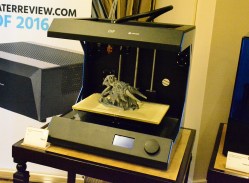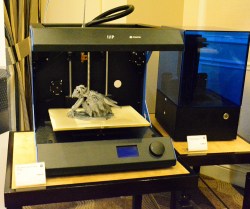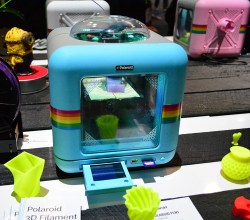CES is over, and now we can take a step back, distance ourselves from the trade show booths, and figure out where 3D printing will be going over the next year.
The Hype Cycle is a great way to explain trends in fads and technological advances. VR and autonomous cars are very early on the Hype Cycle right now. Smartphones are on the plateau of productivity. 3D printing is head-down in the trough of disillusionment.
For this year’s CES, 3D printing is not even a product category. In fact, the official documentation I found at Prusa’s booth listed their company in the ‘Assistive Technologies’ category. These are dark days for the public perception of 3D printing. The source of this perception can be brilliantly presented in a pair of graphs:
The perception of 3D printing has been tied inexorably to Makerbot. Makerbot presented the only 3D printer on The Colbert Report. Only Makerbot had their 3D printing storefronts featured on CNN. It’s been like this for half a decade, and hopefully things will get better.
This doesn’t mean 3D printing isn’t improving. In fact, it’s the best it’s ever been. CES had the most innovative printers I’ve seen in years. I caught a glimpse of this year’s top-selling printer (and it launches in April). Resin machines are going to be very popular soon. What did CES have to offer? Check it out below.
Big Machines
Large 3D printers have been around for years now. That’s not to say building a large form factor 3D printer is easy – the strength of materials doesn’t scale linearly, and all that stuff Galileo figured out 400 years ago and whatnot. I need only to point at the Part Daddy as evidence of how hard it is to make a truly huge printer.
 However, this year we’re seeing some interesting approaches to building bigger printers. The Cronus from Titan Robotics is a five-toolhead machine using very advanced slicing algorithms to print large objects faster. The Cronus is based on Autodesk’s work on Project Escher (and there’s a Cronus at Pier 9), to use multiple extruders and nozzles to print a single object. It’s very, very heady stuff and it’s awesome to see this in the wild.
However, this year we’re seeing some interesting approaches to building bigger printers. The Cronus from Titan Robotics is a five-toolhead machine using very advanced slicing algorithms to print large objects faster. The Cronus is based on Autodesk’s work on Project Escher (and there’s a Cronus at Pier 9), to use multiple extruders and nozzles to print a single object. It’s very, very heady stuff and it’s awesome to see this in the wild.
Big filament printers are one thing, but if you really want a mind-bending build you need to check out the zSLTV from UniZ.
The zSLTV is a resin printer, but unlike every other resin printer that either pulls a part up or sinks a part down into a pool, this thing prints sideways. Basically, it’s a giant tub with a Z (X? or Y?) platform submerged in resin. On one side of the tub is an LCD and a few UV LEDs. It’s huge, fast, and very high resolution. Yes, you’ll need 60 or 70 gallons of resin, but if you need this capability you probably don’t care much about cost.
Inexpensive Machines
Last year, Monoprice made a few waves with the announcement of a very inexpensive filament printer and an unbelievably cheap resin printer. The resin printer was a failed experiment and was never released, but the Monoprice MP Mini Select was really, really good.
This year, Monoprice is doubling down on inexpensive machines with a $150 delta printer, and what might be the least expensive resin printer we’ve seen. There’s going to be a second version of the MP Mini Select, with improvements taken directly from the community’s tinkerers. Next month, Monoprice will release their top-of-the-line resin printer, at a price comparable to the Form1s and other high-end STL printers on the market. Also of note in the Monoprice suite is the MP 3Series Commercial Printer, referred to by the Monoprice team as the ‘3Mill’. This will be available for $800 in a few months.
A year or two ago, it seemed every company was presenting a 3D printer at CES. This year? Not so much. The Bosch booth didn’t have a Dremel printer on display, but Polaroid did have this tiny cube of a printer:
Software
Hardware isn’t any good without the software to drive it, and this year Lulzbot is taking the lead with some great announcements. The software stack has always been the weak point of resin printing, and now Lulzbot is working with Monkeyprint to improve the state of SLA printing. They’re working on their own edition of Cura, and the Blender Foundation is getting some help from Lulzbot.
Materials
The MarkForged booth was showing off some impressive parts printed in metal. Their system uses powdered metal contained in a filament. After printing is complete, this plastic is dissolved and the part is sintered. It’s an expensive machine at around $100k, but it’s still a very interesting technology.
All filament 3D printers have a basic problem with the strength of the parts they produce. Parts are strong on the X and Y axis, but not on the Z axis because inter-layer bonding is the weak link. Essentium Materials has the solution. They’re producing a line of filament clad in a very thin layer of carbon. Once the part is printed, it’s heated with RF, bonding the individual layers to each other. It’s a clever solution, and relatively simple to implement on existing printers.
Looking forward to 2018
What does the future hold for 3D printing? It’s going to take a while for the general public to realize that you can do more than print low-poly Pokemon. Until that time, we’re happy to sit back and enjoy the best 3D printing has to offer. The technology has never been better, and it’s only going to improve from here.






















At CES where are the affordable, trouble-free, quick solutions for making on-demand PCB’s at home? Nowhere – I guess it’s more important for the “Makers” to “Make” lousy Yoda Heads in 3D – and post them to Instagram/Facebook.
Your salt will go well with our fries
Username checks out.
The NexD1 on Kickstarter right now is exactly that
The NexD1 is a scam. I’ve handled the parts they claim to have produced, and they didn’t make them. The CEO swore up and down to me that Objet standard sample parts and heavily acetone-smoothed FDM parts came from the same printer, and their supposedly printed circuits weren’t made of printable materials. Pictures and more info here: https://groups.google.com/forum/#!topic/3dprintertipstricksreviews/gptNAKZhaMM
Ok, we get it, you work for Stratasys and this eats your lunch. We’ll see over the next couple of weeks what the real deal is with NexD1
Read through the recent comments on the kickstarter campaign, then I’ll accept your apology.
I’d argue that making a PCB-printer is a significantly more difficult problem than making a 3D printer. There are some shortcuts (conductive ink, milling machines, etc), but if you want a PCB that’s worth a damn, I know of only one solution: chemically etched copper-clad FR4. The machine would need to be able to pump around strong acid, and be something that I’d be comfortable keeping in my living room.
Heck, just the machinery to reliably place through-holes and vias is 90% of the way to being a 3D printer!
I’m sure there are some brilliant people working on the problem right now, but I expect that true PCB manufacturing will be an industrial scale job for quite a while.
It’s also a much narrower-use item. 3D printers are being used across a huge swatch of industry and hobby.
It’s also something that traditional manufacturers have gotten to be SO good at, especially in terms of “batching” techniques – that it’s almost impossible to have a proper “value” proposition for a home unit that competes with the likes of OSHPark and BatchPCB.
While it’s currently very easy to have a “value” proposition for a 3D printer that beats Shapeways.
High end PCB mills outperform chemically etched boards by quite a lot – it’s not crazy to get sub-5 mil trace/space performance from a high end PCB mill. Of course, the ones I know of are commensurately expensive (~$30K+). The Othermill Pro is way cheaper (~$3200) with only a minor step down (6 mil trace/space). Still expensive, though.
It may not have occurred to you, but some problems are in fact harder to solve than others. You’ll notice that your flying car and cure for cancer are also MIA. Is that also due to “Makers” and that damned Instagram/Facebook they parked on your lawn?
For this specific problem: between OSHPark and a sea of Chinese PCB fabs, there’s a low ceiling on how much most people are willing to pay for PCBs now, as well as a floor on acceptable quality and features. Making PCBs at home was much more interesting when commercial providers would charge you $100+ for a small board with no silk.
Considering how one can have professional PCBs made for as little as 20$ (5 pieces, Myro), I truly fail to see the point in wanting to make boards at home. When we did that back in the ’70s, it made sense because professionally made prototype boards cost 500$+ back then. But I would *never* consider keeping ferric chloride in my home shop again—I once had the displeasure to find all the tools in the same room had rusted from the fumes alone because the fume hood had failed!
“CES” is the *Consumer* electronics show. How many consumers (not makers) are likely to go to their local WalMart to get PCB making gear? That’s why the various on-demand PCB system companies don’t go there. And they’ve been around for decades.
I always felt like the term “Hype Cycle” was a misnomer as it is not a cycle. I guess “Hype Damping Oscillation” doesn’t have the same ring to it.
Wachoo talkin’ ’bout, Willis? It is a cycle that starts at zero enthusiasm and returns to it. By your definition, your use of “oscillation” is screwed up
Finally, we have a bright future of high poly pokemon figurines ahead of us.
I thought VR hype started way back in the 90s with The Lawnmower Man and Virtual Gameboy…
No doubt that that true PCB manufacturing will be an industrial scale job for quite a while. I have to doubt that there are truly brilliant people working on the problem, because there is no problem for many. The chances of US manufacturing exported to China and elsewhere returning to the USA was slime to none, and slim left town long ago. With President elect chump backpedaling as hard as he can I hear slim has moved to an alternate reality.
Although I could still be proven wrong, but I never believed 3D printers would become a mass produced tool for consumers., as I don’t think the potential sales are there. I can’t believe within the aggregate DIY community there are that many who need or want to construct one off or limited runs of components to justify the cost of a machine. The artist constructing trinkets market would saturate quickly.. S those who want a 3D printer are back to where they have to build one themselves. While building their own one could can build a speculative unit in hopes of making enough to pay for the tool they keep for themselves or save a substantial amount at least.
The Monoprice Mini Facebook group just passed 4,000 members. That little printer has possibly become the most common 3D printer there is. Monoprice will be offering a kit to upgrade original Mini’s to V2 spec.
I am kinda poor and living in a country with terrible mail and terrible tool and repair part availability. I sometimes feel like I am living on a mars colony for the amount of printing for repairs or fabrication I require. Same for having plenty of perforated PCB and components, sometimes I have to waste stock of bits and bobs I keep to make for a high price today which might never arrive for $5 and free shipping from China, or the post might decide that whatever it is might be a $10k prototype and make me pay or send it back.
The Polaroid printer, with snap-off control panel
I was thinking they made the nyan cat printer!
Small comment on the hype cycle. Consumer 3D printing is in the disillusion area, professional desktop 3D printing is speeding up the enlightenment slope right now.
Ultimaker employee here, are sales are stronger then ever, even if we have a too expensive machine for the HaD crowd. Companies love our machines.
I wonder who the Polaroid printer is marketed to…is it for kids too young to be trusted with the small parts it can make, let alone something that is basically a precision hot glue gun? It doesn’t have enough of the Nyancat thing going to sell on that alone. The appearance could have been nice with a different color scheme…as it is, the front panel is too ugly for anyone who doesn’t love 1950’s refrigerators while the rest doesn’t match so even that tiny segment won’t like it. Then there are the rainbows…not sure what is up with that…if they are trying to sell to young girls they could have done better with unicorns or ponies. Maybe they are just trying to get into the news for being banned in Russia, thus ensuring sales…but even then, why the terrible color scheme?
AFAIK polaroid is now just a bare brandname rented out to the Chinese for selling typical Chinese low-cost stuff.
You do know that the ‘hype cycle’ is a load of management consultant bullshit, right?
Just waiting for the Carbon3D printers to find their way to the print services like Shapeways. Prints shipped same day, yes please.
I like the two graphs. So…we should invest into the Stratasys stock now…? Who knows.
The Cronus looks impressive, but not very rigid. Maybe I’m wrong.